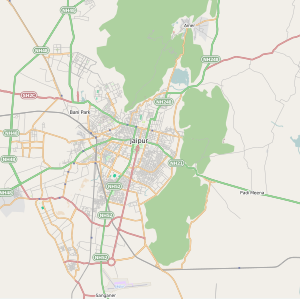Jaigarh Fort
| Jaigarh Fort Victory Fort | |
|---|---|
| Part of | |
 Jaigarh Fort | |
| Coordinates | 26°59′09″N 75°51′03″E / 26.9859°N 75.8507°E |
| Type | Fort |
| Site information | |
| Controlled by | Jaigarh Public Charitable Trust |
| Open to the public | Yes |
| Condition | Good |
| Site history | |
| Materials | Red Sandstone |
| Battles/wars | 436 |
| Events | Death of Dara Shikoh |
| Garrison information | |
| Past commanders | Shazada Jalal Muhammad Mirza Mughal Empire |
Jaigarh Fort is situated on the promontory called the Cheel ka Teela (Hill of Eagles) of the
The fort, rugged and similar in structural design to the
Geography
The Jaigarh Fort, located on one of the peaks of the Aravalli range of hills is built about 400 m above the Amer Fort.[1] It provides an excellent of view of Aravalli hills and the Amer Fort down below.
The fort is 10 kilometres (6.2 mi) away from Jaipur city. It stands on a short diversion from the Jaipur-Delhi Highway, which leads to the Jaivaan cannon at the Dungar Darwaza ('Darwaza' means "gate"), the same road leads to another important fort called the Nahargarh Fort. It can also be approached from the Amer Fort over a short climb along a steep hill track, arriving at the Awami Gate near the fort museum.[1][4]
History

Amer was known in the ancient and medieval period as
Cannon foundry
During the reign of the
Description

The fort is highly fortified with thick walls of red sandstone and is spread over a layout plan with a length of 3 kilometres (1.9 mi) and a width of 1 kilometre (0.62 mi); it has an impressive square garden (50 metres (160 ft) square) within it. Ramparts in each corner are sloping and provide access to the upper level structures. The palaces have court rooms and halls with screened windows. A central watch tower on a raised ground provides excellent vistas of the surrounding landscape. The Aram Mandir and the garden within its courtyard, on the northern side of the fort complex, has a triple arched entrance "The Awani Darwaza" which was refurbished in recent times to get fine views of the Sagar Lake (an artificial lake); water from this lake used to be transported to the fort in pouches loaded on elephant backs and also by humans carrying water pots.
The water supply facilities in the fort was met by creating water harvesting structures in the vicinity in the Aravalli catchment and conveying water through a canal on the west side of the fort over a 4 kilometres (2.5 mi) distance (seen at site) to be stored in three underground tanks below the central courtyard. The largest tank had a capacity of 6 million gallons of water. There were completely false rumors, that a treasure belonging to the
- Armoury
The armoury chamber here has a wide display of swords, shields, guns, muskets and also a 50 kilograms (110 lb) cannonball. Pictures on display are old photographs of Jaipur's Maharajas namely,
- Museum
The museum is located to the left of the Awami Gate; it has exhibits of photographs of the Royalty of Jaipur, stamps and many artefacts, which include a circular pack of cards. A spittoon of 15th century vintage and also hand drawn plan of the palaces are seen in the museum.[4]
Jaivana cannon
Jaigarh Fort was a centre of artillery production for the
The Jaivana was manufactured during the reign of Maharaja Sawai
Ticket
The entry fee for Indians is ₹150 per person and the entry fee for foreigners is around ₹200 per person. Student can show their Id cards and can have some discount.[12]
Timings
The gates of Jaigarh Fort open at 09:00 hours and close at 18:30 hours throughout the week. It is not advised to stay here in the evening as Jaigarh Fort is surrounded by thick deciduous forest. Nahargarh sanctuary[13] is a part of the forest, and therefore wild animals lurk in the dark.
In popular culture
Jaigarh Fort was the Pit Stop of the 6th leg on the American reality show The Amazing Race 14.
Gallery

References
- ^ ISBN 978-0-470-55610-8.
- ^ ISBN 978-0-8122-4025-2. Retrieved 16 April 2011.
- ^ a b c d "Jaigarh Fort – Jaipur, India". cs.utah.edu. Archived from the original on 11 March 2014. Retrieved 14 April 2011.
- ^ a b c d e "Jaigarh Fort – Jaipur". Mysterioustrip.com. 2 December 2017. Retrieved 14 February 2023.
- ISBN 978-81-85176-48-2. Retrieved 16 April 2011.
- ^ "- YouTube". YouTube.
- ^ a b c "Jaipur". Jaipur.org.uk. Retrieved 16 April 2011.
- ^ "Awani Darwaza (Jaigarh Fort)" (PDF). Indira Gandhi national Center for The Arts. Retrieved 16 April 2011.
- ^ ISBN 978-1-84353-089-3.
- ^ India. Parliament. Lok Sabha (1977). Lok Sabha debates. Lok Sabha Secretariat. p. 133. Retrieved 16 April 2011.
- ^ C.N.Anand (24 October 2009). "Chequered past". The Hindu. Retrieved 16 April 2011.
- ^ "Jaigarh Fort Jaipur - Entry Fee, Timings, Location, and more". Exploremania.in. 23 January 2022. Retrieved 24 January 2022.
- ^ Dey, Panchali. "Two new ecotourism spots to open for tourists in Jaipur". The Times of India. Retrieved 11 December 2019.


